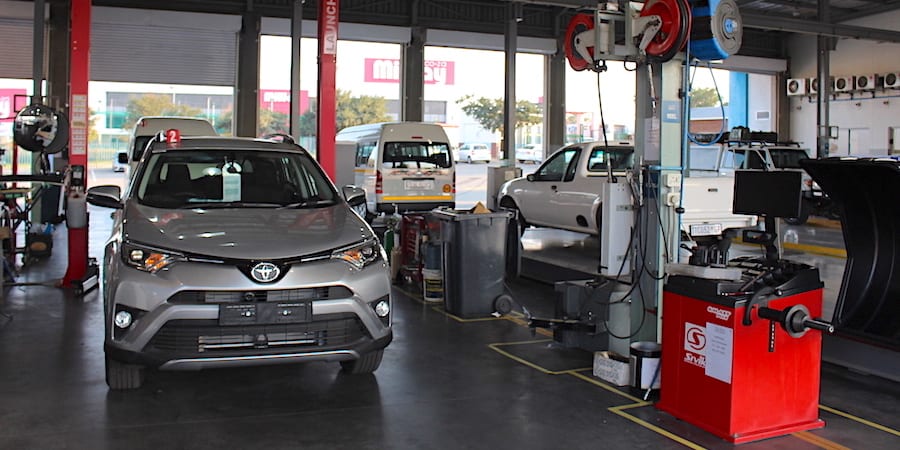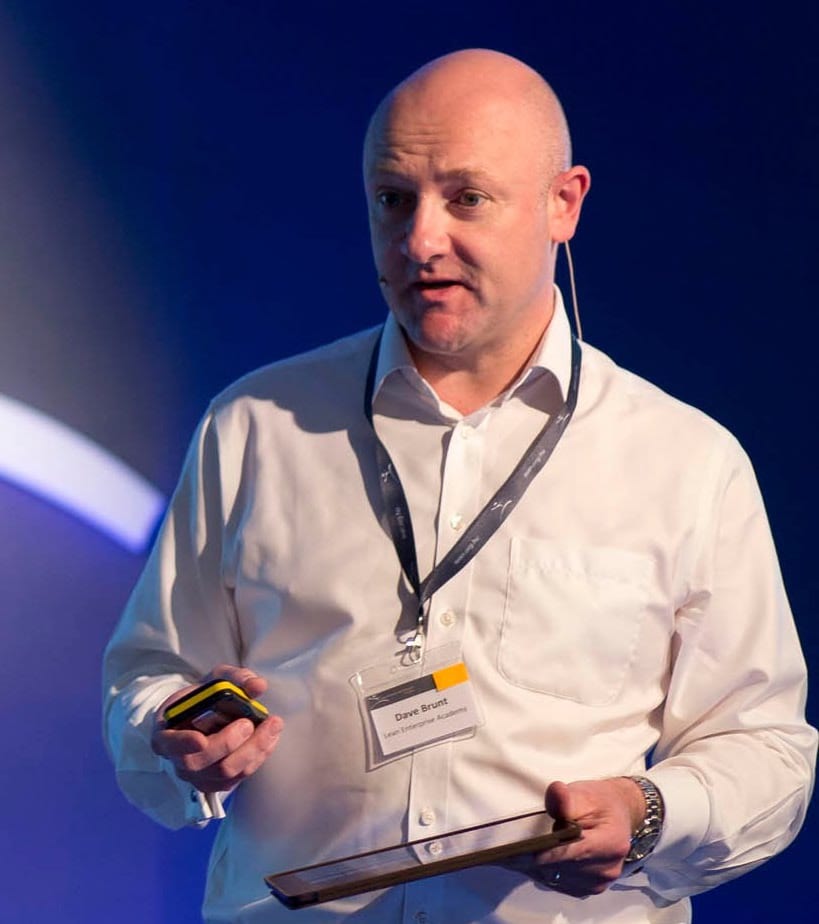
Developing our people to flow value to our customers
CASE STUDY – One-piece flow and a focus on lean leadership and kaizen have allowed the Halfway Production Centre in Johannesburg to turn itself around in just 14 months.
Words: Kirstin Wallis, General Manager, and Morné Fourie, Process and Development Specialist, Halfway Production Center
The Halfway Production Centre (HPC) opened in February 2016, when the vehicle preparation facilities of two dealerships in the Johannesburg area – Honeydew and Fourways – were amalgamated. At HPC, we receive vehicles from Toyota South Africa, perform pre-delivery inspections on them (PDIs) and get them ready for delivery, fitting accessories as specified by the customer.
When the two centers merged, we inherited most of their staff. At the time, people didn’t know each other, there were no processes in place and each fitment was done in a different way. It seemed that, back then, all we did as managers was run around fighting fires. We were expediting cars, jumping cars, moving cars, reversing cars – it was pure chaos.
We wanted to become a fitment center where not every single vehicle is urgent and where the decision on what car is worked on next doesn’t sit with the salesperson or manager who shouts the loudest. Our ultimate purpose was to perform 100% complete and accurate vehicle preparation for customer delivery in a known, reliable time – and to develop our people’s capability to improve the work every day. To achieve this, we turned to lean, shifting our focus to quality and delivery of the vehicles (customer fulfilment) and to the actual work.
We realized quickly that the first thing we would have to do was to bring stability to our processes. Without that, we could have never hoped to improve them. This would mean daily customer fulfilment measures (internal quality and delivery), daily feedback metrics from the dealerships and a lot of time spent in the workshop with the team understanding the work and why some of the problems occurred.
What it took us longer to understand was how important peoples’ capabilities were to the fulfilment of our purpose. At first, we simply tried to impose lean on our people, but it didn’t stick. People were doubtful and thought we were crazy. In this article, we will explain how we managed to change the culture of HPC, and how this enabled us to perform a turnaround in just 14 months.

LET IT FLOW
These days we don’t have to run around fighting fires all over the place, but getting to where we are now – stability – entailed a lot of trial-and-error and experimentation. Indeed, it took a few months to get to a point where experiments became a part of our daily lives at work.
When everyone became more comfortable with the idea of change, we were finally in a position in which we could start trying new things. First of all, we made a huge effort in trying to really understand how our system worked and then we introduced stricter one-piece flow rules into it. Today, we treat cars like we would marbles in a hose pipe: we put one car into the flow and 330 minutes later it comes out on the other side with a full house of all the possible fitments (before this type of work would take up to 5-6 days).
When we started, we set a few rules that we would try our best to follow:
- Focus on value for the customer (our dealerships and the final users);
- Safety first and respect for our people;
- We only start working on a vehicle if the requisition form is complete and accurate, the vehicle and all parts are ready, and if there is a slot available in the flow;
- We don’t pass on poor quality. We strive to get in-bay quality at every stage, which is also why we don’t have a final quality inspection. In case of a fault detected late (like a bubble in the safety foam, for instance), we wait for a gap in the flow, fix the problem and bring the car back to the dispatch area for delivery;
- Batching is evil and we avoid it, even when our suppliers and customers are doing it;
- Never jump a car out of sequence or reverse a car. No car can get in front of the one ahead;
- Protect the front-line team and fill any gaps in the front line caused by absenteeism, even at the cost of stripping support functions bare.
Right from the start, we made a big issue if we had to override one of these rules, each time investigating the cause of the problem and whether an experiment or a change in flow were required to solve it. Experiment after experiment, the team started to have an opinion on how the flow should work and came up with ideas that we could try and test. Building their trust in our reactions to experiments took time, but once the culture shifted it unleashed a torrent of creativity.
Achieving the “current best” flow took several iterations and lots of the teams’ input [when PL visited in May, the Production Centre was at version 6.1 of their value stream]. We played around with different processes and sequences (trying several things, from removing buffers to combining different activities) until we finally established what gives us the best and most stable performance, at least for now. Before each major flow change, we showed the team the idea on our site layout wool diagram and simulated the changes with toy cars to establish if there were any concerns or factors that hadn’t been considered. We were often scared the next iteration might “break the system”, until we accepted the mistakes happen and that doing kaizen after each iteration ensures that even unsuccessful measures become sources of learning and improvement.
Once a change was implemented, we walked around and highlighted all the issues we could detect, coming up with a few more experiments we could run to hopefully optimize the work and get one step closer to the ideal flow. We believe it is our job as managers to design the best system we can, but the issues that these changes raise in the front line are best solved by the people doing the work. The involvement and commitment to solving the small problems was the surest way to create sustainable buy-in.
Our process time improved from 431 minutes to 287 minutes, and our lead-time went from 761 minutes to 349 minutes in just eight months. We also established more detailed standards to build higher quality into the work (each team is accountable and picks up problems on the vehicles as they enter their bays). What was amazing was that our percentage complete and accurate increased from 20% in May 2016 to 64% in May 2017.

We operate in a very large site, which we share with two vehicle rental companies, a retail roadworthy operation and a truck sales and service workshop. There is a lot going on all the time, which made flow even more impactful. We have three lanes at our disposal, plus a separate area that we use for rubberizing (a process by which we spray a protective rubber coating on the cargo area of pick-up trucks). We have 11 bays across the site: PDI (representing the highest-volume job in the shop, and the only part of the process where we allow a buffer), radio, safety film (smash-and-grab window protection – taking place over two bays), nudge bar, tow bar, tracker, rubberizing (three bays) and style bar. Outside the workshop, we have our new vehicle dispatch area, with its very effective visual cue: cars facing the highway are ready for dispatch, while those facing the workshop have a problem that we couldn’t resolve and are waiting for a new part or way to fix it.
Every time the dealer sells a vehicle, work will be required to make it ready for the customer. If a vehicle needs to visit all of our bays – each of which works to a 30-minute takt time – it will be ready in five and a half hours. This means that the first seven cars we work on each day will be ready before close-of-business and the ones we begin to work on in the afternoon will be completed by lunchtime the next day. By contrast, in the past the dealerships had to wait up to five days for a vehicle to be prepared for delivery!
Certain vehicles need to spend longer than 30 minutes in some of the bays (mounting a tow bar on a Fortuner, for example, is particularly time consuming), and we are working to reduce that time, too, and to help the team to problem solve why the fitment took longer than our takt time. But even for those vehicles, we can now tell the dealer when exactly they can expect delivery. This forces us to plan ahead, avoid jamming the workshop with vehicles, and properly optimize our workshop and our work. We know what we are expecting to come out of our bays every day, and the times we have committed to. We try to walk every hour or hour and a half to see if we are ahead or behind of plan and to assist if we are needed. At the end of the day we also compare the actual completion time to the planned completion time, to understand why there was a deviation and how we could fix it going forward.
It is easy to forget how bad things were before we introduced lean thinking at the Production Centre, but there is no doubt that one-piece flow has led to an extraordinary time compression and built-in work quality.
BUILDING TRUST AT THE GEMBA
For our Christmas Party last year, we organized a company braai [a BBQ in South Africa] and put a whole bunch of before-and-after shots up on a wall, so that people could see how much things have changed since lean was introduced. They were so excited!
From the building of some of the bays to general housekeeping and placing tools in trolleys, from flow changes to 5s, we have really revolutionized everything here, one bay at a time, using the experience and suggestions of our people.
As we mentioned earlier, the cultural shift that enabled this was not easy to accomplish. People might flag up problems voluntarily today (using andons in the form of battery-operated door bells), but it took us about six months to get them to trust us. It really came down to us changing our own attitudes as managers and how we reacted to problems. We started to show our faces at the gemba more and more, appearing whenever a problem occured, making sure people knew we are here for them, and approaching problems positively, without blame and in a structured manner. (What happened? Why did it happen? What experiments can we run to try and fix it? How do we ensure it doesn’t happen again?) We also try to share in our morning meeting (Asakai) any important learnings with the team from the previous day – to help with communication and openness.
Before people could change, we had to change. These days, we are out of the office most of the time. We are directly involved in the work. If people call us, we run, because they need to know how important they are to us and that none of what we have achieved would have been possible without them.
After our first attempts to force lean onto them, we realized we had to let things happen more organically. We have found that if someone is given a solution and doesn’t properly understand the pain that was involved beforehand, they probably won’t follow the rules. The team writes their own standards, which makes it more likely that they will follow them. It also means if they miss something they take accountability for it. There is no doubt that the tremendous improvements we have made would not have been possible without standardization.
We constantly encourage people to come up with and follow standards, using Asakai to set expectations, reflect on what we see and on the state of the work. We have implemented standards that make our people’s jobs easier. In fact, many of the kaizens came from the technicians themselves, like hanging the hose used in the rubberizing bay to the ceiling, rather than having one of the technicians there hold it while the other sprayed (resulting in 30 minutes of freed-up capacity for each rubberising fitment with an improvement that cost R750.)
For us, the trick was to create opportunities for our people to see problems, because when they see the problem, they come up with solutions. Instead of telling them what to do, we have started to design what we call “kaizen tasks” so that people are encouraged to work on tackling a problem on a daily basis and internalize the new way of working in a seamless and more effortless way. If I just tell you to keep all your tools in a trolley, you will do it for a while and then stop, but if I give you the task to improve the way you use organize your tools, you will devise the best solution by yourself.
There’s no doubt the biggest changes at the Production Centre appeared once we started to challenge people to improve the work, rather than tell them how to do it. Here’s an example: it used to take people four minutes to get ready in the morning, meaning they were always starting work on the first car late. We challenged them to get ready in 60 seconds or less. At first, they said it was impossible, but then we started to run a few experiments and the solutions came from them – they managed to get ready for their first car in less than 20 seconds! We can’t stress enough how important it is to build a strong relationship with people.
That the success of a transformation hinges on management might not be news to Planet Lean readers, but it was still quite the realization for us. Upon reflecting on what had contributed to the success of the transformation at HPC, we wrote down all the things we thought had made and impact on post-it notes. We then plotted these against the Halfway version of the Lean Transformation Framework house (see picture below), which encapsulates our corporate strategy. The clustering of post-it notes we placed under management behaviour and basic thinking gave it away: it’s the alignment and consistency of the two that made our turnaround successful. Sure, improving the process and developing capabilities is important, but no house ever stood too long on fat pillars and weak foundations!
Alignment on purpose and the fact that we live and breathe that purpose in our daily roles has permeated into the team and created deep foundations for our company culture. We must say that consistency of purpose and clarity of direction has been one of the core skills we have been able to develop over the last year. We have changed so much: our personal development has been dramatic (our coaches Terry O’Donoghue and David Brunt have always challenged and guided us) and our understanding of the role and methods in line management is light years away from where it was before we were entrusted with this site. The freedom to experiment and build our own culture has been a rewarding and fulfilling experience.

REFLECTIONS FROM THE COACH

When we put processes in a flow we can have a dramatic impact on quality, lead-time, cost and space reduction – but we must focus on quality, too, or all that flow will achieve is delivering poor quality to the customer faster! With stable quality comes improved on-time delivery. All this is the value the customer desires.
We should strive to link customer fulfilment with real problems, and it’s very important for both management and front-line workers to see this connection, so that, in time, people become autonomous in solving issues. At the beginning, this is quite challenging: a flow is fragile and things can’t all be OK every day. We must accept that performance can be red: if we are honest about the measurement, there will be lots of problems every day. More important than showing red and green is visualizing why. HPC has done so very well, but most businesses struggle with this – nobody like 20%, we all want 100%. Our schooling is to blame for that.
Once a process is stable, we need to break it down again and again, to deliver ever more value to the customer – this is what continuous improvement really means. At HPC, each time stability occurred, the team looked to further improve the process and compress time (be more responsive in the delivery of the vehicles to the dealerships). Continuously breaking a process to highlight the next area for improvement strengthens everyone’s muscles for improvement.
Beware if all your charts are green! The work of management is not to get KPIs in the green, but to set the direction (the problem to solve, in line with value as defined by the customer), define the value stream (setting standards for it and defining the next improvements), and develop people into autonomous problem solvers and continuous improvers.
Dave Brunt, CEO, Lean Enterprise Academy
Have you watched our documentary on their lean transformation yet?
THE AUTHORS


Read more


INTERVIEW – Atlantis Foundries was able to achieve zero defects for three months in a row thanks to machine learning. Here’s why the human component can’t be discounted.


FEATURE - Professor Dan Jones looks at the unique challenges the digital age presents the business community with, and explains how lean thinking can help us to effectively address them.


FEATURE – What is psychological safety? What is it not? This article explores its advantages and foundational elements, and how organizations need to transform their leadership to achieve this evolution in management.


FEATURE – As many retail giants are finding out, great customer service is no longer enough to ensure competitive advantage in a world where the digital revolution is taking no prisoners.

